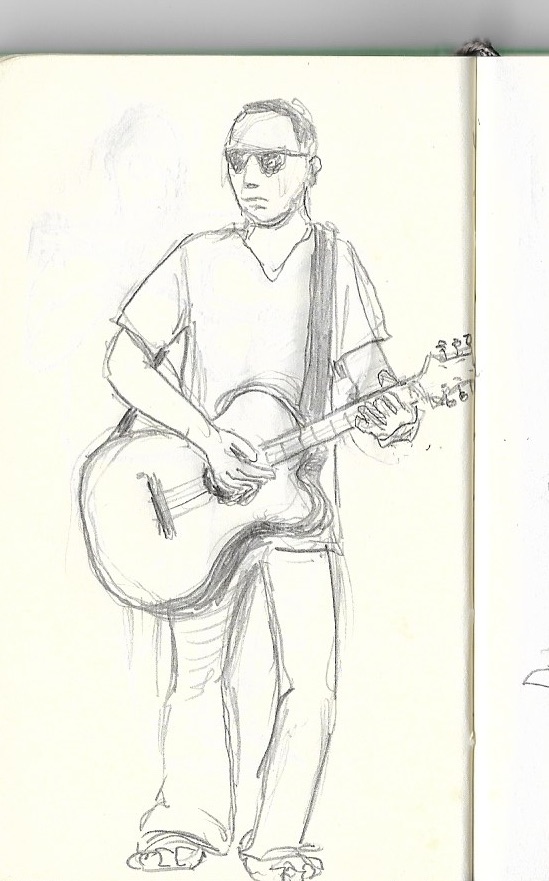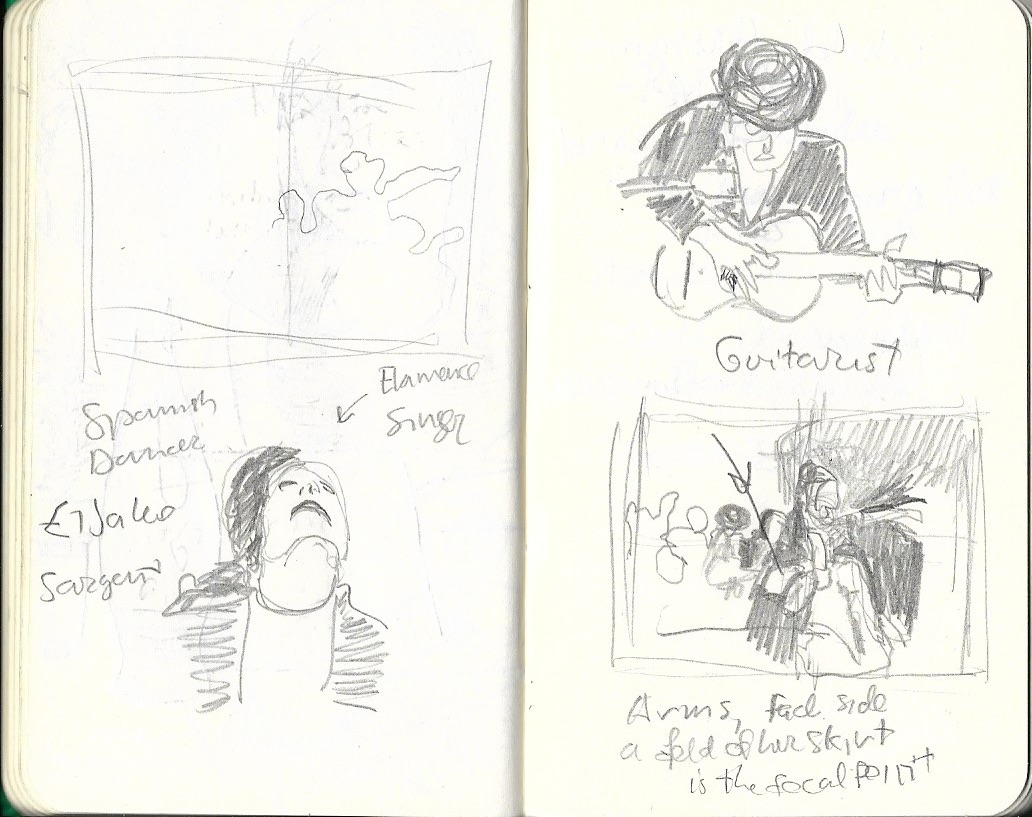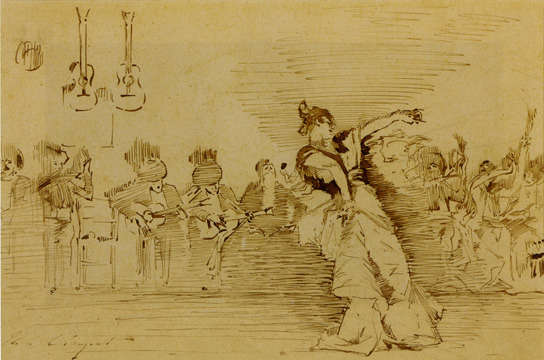The Blue Guitar
I was just at the La Crosse Folk Festival in Wisconsin where my daughter and I participated in a song writing contest (we came in fourth, in case you are wondering). I was reflecting, as I listened to a variety of compositions played on a sunny afternoon in a big circus tent, on the power of the guitar to communicate human emotions. This guy, for example, was way down inside himself and wanted us to go there with him, through the medium of his instruments.

The guitar has only recently become the prime instrument for the extroversion of feeling. Guitars have always been around, but became popular at the turn of the 20th century (surpassing fiddles, for example) primarily because they were fairly easy to manufacture and make available inexpensively through mail-order catalogues. Guitars could reach out-of-the-way communities at a reasonable price: poor Appalachian whites, or southern blacks, for example, took up the instrument with enthusiasm. And it turns out a guitar is an excellent portable accompaniment to the human voice. As one online commentator put it, “It’s chordal like a piano, though not as strongly so. It’s expressive and vocal like a sax, though again not as strongly. It covers a pretty broad range of notes across what people ordinarily sing in. You can get many sounds ranging from legato almost violin tones to percussion.” A guitar is the human instrument par excellence, which has led to its current status as the most popular instrument in the world.
This reminded me of a thumbnail sketch I made of a John Singer Sargent painting this summer. The work was El Jaleo, a Spanish tavern scene. It was a study in chiaroscuro, depicting a Flamenca dancer at the climax of her performance, but sitting against the wall in the background is the line of guitarists and a singer, all of whom drive the dance to its emotional crescendo. I sketched one of the guitarists, because he seemed to perfectly represent the use of the guitar as a kind of emotional prosthesis: I also sketched the singer, whose head is thrown back, eyes closed, throat vibrating with the intensity of the moment.

You can view the painting if you google it, but here is Sargent’s own preliminary sketch for the painting (in keeping with this blog’s sketchy aesthetic):

Of course we are left to imagine the music, but we have all been similarly effected by such a moment–when the human voice, accompanied by the voice-like guitar, seems to put us in a heightened state.
This took me in turn to the poet Wallace Stevens, and his poem “The Blue Guitar.” It’s a long and complicated poem, but here’s the bit people tend to remember:
I The man bent over his guitar, A shearsman of sorts. The day was green. They said, "You have a blue guitar, You do not play things as they are." The man replied, "Things as they are Are changed upon the blue guitar." And they said then, "But play, you must, A tune beyond us, yet ourselves, A tune upon the blue guitar Of things exactly as they are."
If you are a Modern, you believe that “things exactly as they are” must mean their material substantiality: that is, things are real insofar as they are exterior to the mind and measurable. Stevens’ poem takes issue with this. Moderns are obsessed with epistemology, and this makes them poor empiricists sometimes. They are quick to divide the real from the unreal, based on a prejudice for hard objects. Well, a Modern might say, we might measure your heart rate, the presence of certain chemicals in the blood. . . the frequency of the sounds you are hearing. . . but the song itself isn’t “real”–it is an epiphenomenon, a mere by-product of physical processes. But is the moment of union we feel when the guitar seems to pluck our very heartstrings unreal? That would imply that it could not be a cause, it could not make things happen. And yet–to get back to the song-writing contest– here was a tent full of people, brought together by a mutual interest in–not the guitars themselves, which are undoubtedly “real,” but not interesting as simply wooden boxes, and not sounds alone, which are also “real” but not uniformly interesting (as we wouldn’t be gathering to hear five-year-olds bang on guitars)–but rather in particular patterns of sound that make particular affects arise in human beings. Patterns make a difference and difference is, well, information. A song is as much information as an equation is, and its results are even reproducible, which explains record sales.
But what kind of information? Oddly enough, the emotional affects stimulated by the guitar seem to increase one’s sense of reality. Song is pregnant with meaning–that feeling of congruence between the inner and outer world. Usually that congruence is not a proposition or claim so much as a quality, a tone, a value. Grief, or melancholia, or nostalgia, for example. Joy, sympathy, affirmation. Such feelings, once evoked, speak to our existential condition: our limits, our agency, and the conflict between agency and limitation. It’s interesting that Stevens claims the guitarist is a “shearsman of sorts”–meaning, he is at first reducing something, clipping it. That is of course essential to art: first there must be a frame, a boundary, into which the composition can fit. Without the limits of art–the musical scale, the six strings, the finite number of frets, the enclosed volume of air in the guitar’s body–there can be no coherent pattern. Once there is a pattern, the relations within the pattern–harmonies and dissonances, tonal dynamics, etc.–can create meaning. And when musical patterns are combined with the separate patterns of human language, as happens in song-writing, we have a doubling of meaning. On the one hand, music points beyond language, to those existential conflicts that arise from our being individual organisms embedded in a larger tissue of life; on the other, language, with its capacity for narrative and for propositional statements, connects the more abstract, universal feeling tones to particular characters. The lyric “I” of the singer reconnects the abstraction of music with the human particular.
I spent some part of my summer reading Cary Wolfe’s What is Posthumanism. Wolfe is trying to explain the systems theory of Niklas Luhmann, another one of those prominent European thinkers we never hear about. Wolfe summarizes systems theory with the provocative statement that “systems increase their contacts with their environments paradoxically by virtualizing them.” To put this in human terms, we create little virtual models of the world in our heads in order to understand the boundlessly complex world outside of our head–these virtual models are how we contact the world. But they can never be the world–the world won’t fit in your head. So far, that’s pretty much philosophy since Kant. But Luhmann is big on process: he claims “Meaning is the unity of actualization and virtualization, or re-actualization and re-virtualization, as a self-propelling process.” We are constantly readjusting our models because they are never enough. Fated to mistake our virtual worlds for the real world, we nevertheless hunger for something beyond. For more reality, that is. For systems that come at the world through meaning (like human beings), Luhmann says that “Meaning becomes for them the form of the world, and consequently overlaps the difference between system and environment.” In other words,
And they said then, “But play, you must,
A tune beyond us, yet ourselves,
A tune upon the blue guitar
Of things exactly as they are.”
Discover more from James Armstrong
Subscribe to get the latest posts sent to your email.
Awesome to see AND read your blog, Jim! Love this.